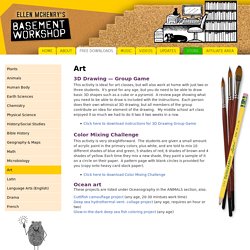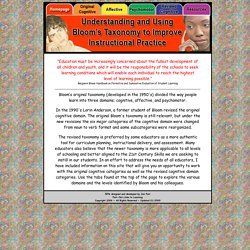

Art. 3D Drawing — Group Game This activity is ideal for art classes, but will also work at home with just two or three students.

It’s great for any age, but you do need to be able to draw basic 3D shapes such as a cube or a pyramid. A review page showing what you need to be able to draw is included with the instructions. Each person does their own whimsical 3D drawing, but all members of the group contribute an idea for element of the drawing. My middle school art class enjoyed it so much we had to do it two it two weeks in a row.
Click here to download instructions for 3D Drawing Group Game Color Mixing Challenge. Science, Technology, Math & Engineering Resources for Kids. BetterLesson: Empowering Teachers' 'Professional Learning'. Alpha for Educators. Share My Lesson - Free K-12 Lesson Plans & Teaching Resources.
Videos, Common Core Resources And Lesson Plans For Teachers: Teaching Channel. LearnZillion. Knowmia - Technology for Teaching. Made Simple. Common Curriculum.
A cloud-based teaching and learning platform for teachers. HowStuffWorks - Learn How Everything Works! SAS® Curriculum Pathways® Free Teaching Resources, Lesson Plans & Worksheets – Promethean Planet. Welcome to Discovery Education. FREE - Federal Registry for Educational Excellence. FREE Features These features originally appeared on the FREE.ED.gov features blog.

The features highlight resources and ideas related to holidays, awareness months, anniversaries and seasonal topics. January February March April May June July August Back to School: 7 Ways to Help Kids Transition Back to the Classroom September October November December About FREE Federal Resources for Educational Excellence (FREE) offered a way to find digital teaching and learning resources created and maintained by the federal government and public and private organizations. FREE was conceived in 1997 by a federal working group in response to a memo from the President. Technology has made it increasingly easier to find information from government agencies or with custom search tools, like Kids.gov. FREE Disclaimer The U.S. Nonfiction Literacy and Current Events.
Videos, Common Core Resources And Lesson Plans For Teachers: Teaching Channel. DWRL Lesson Plans. Free Online Textbooks, Flashcards, Practice, Real World Examples, Simulations. The Learning Network - The Learning Network Blog - NYTimes.com. Sharing what we know. Power Up What Works. The Differentiator.
Try Respondo!

→ ← Back to Byrdseed.com The Differentiator The Differentiator is based on Bloom's Taxonomy, Kaplan and Gould's Depth and Complexity, and David Chung's product menu. Try It In: French Dutch • Tweet It • Like Byrdseed • Pin It Students will judge the ethics of the [click to edit] using a textbook and create an essay in groups of three. Revised Bloom's Taxonomy adapted from "A Taxonomy for Learning,Teaching, and Assessing: A Revision of Bloom's Taxonomy of Educational Objectives" by Anderson and Krathwohl Depth and Complexity adapted from The Flip Book by Sandra N. Depth Big Idea Unanswered Questions Ethics Patterns Rules Language of the Discipline Essential Details Trends Complexity Multiple Points Of View Change Over Time Across the Disciplines Imperatives Origin Convergence Parallels Paradox Contribution Key Words Consequences Motivations Implications Significance Adapted from David Chung and The Flip Book, Too by Sandra N.
Group Size One Two Three Four. Developing Questions for Critical Thinking. “Education must be increasingly concerned about the fullest development of all children and youth, and it will be the responsibility of the schools to seek learning conditions which will enable each individual to reach the highest level of learning possible.”

Benjamin Bloom Handbook on Formative and Summative Evaluation of Student Learning Bloom’s original taxonomy (developed in the 1950's) divided the way people learn into three domains: cognitive, affective, and psychomotor. In the 1990's Lorin Anderson, a former student of Bloom revised the original cognitive domain. The original Bloom's taxonomy is still relevant, but under the new revisions the six major categories of the cognitive domain were changed from noun to verb format and some subcategories were reorganized. The revised taxonomy is preferred by some educators as a more authentic tool for curriculum planning, instructional delivery, and assessment.